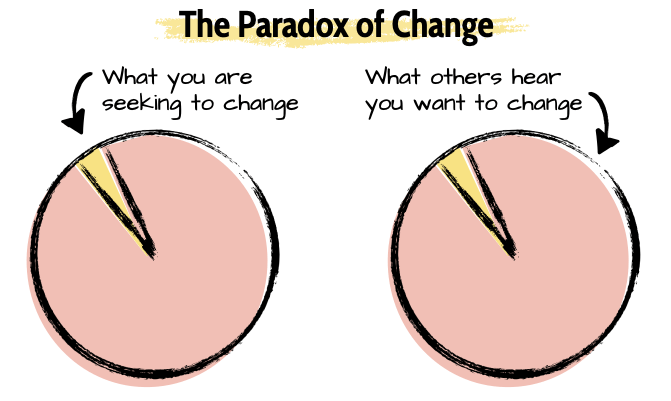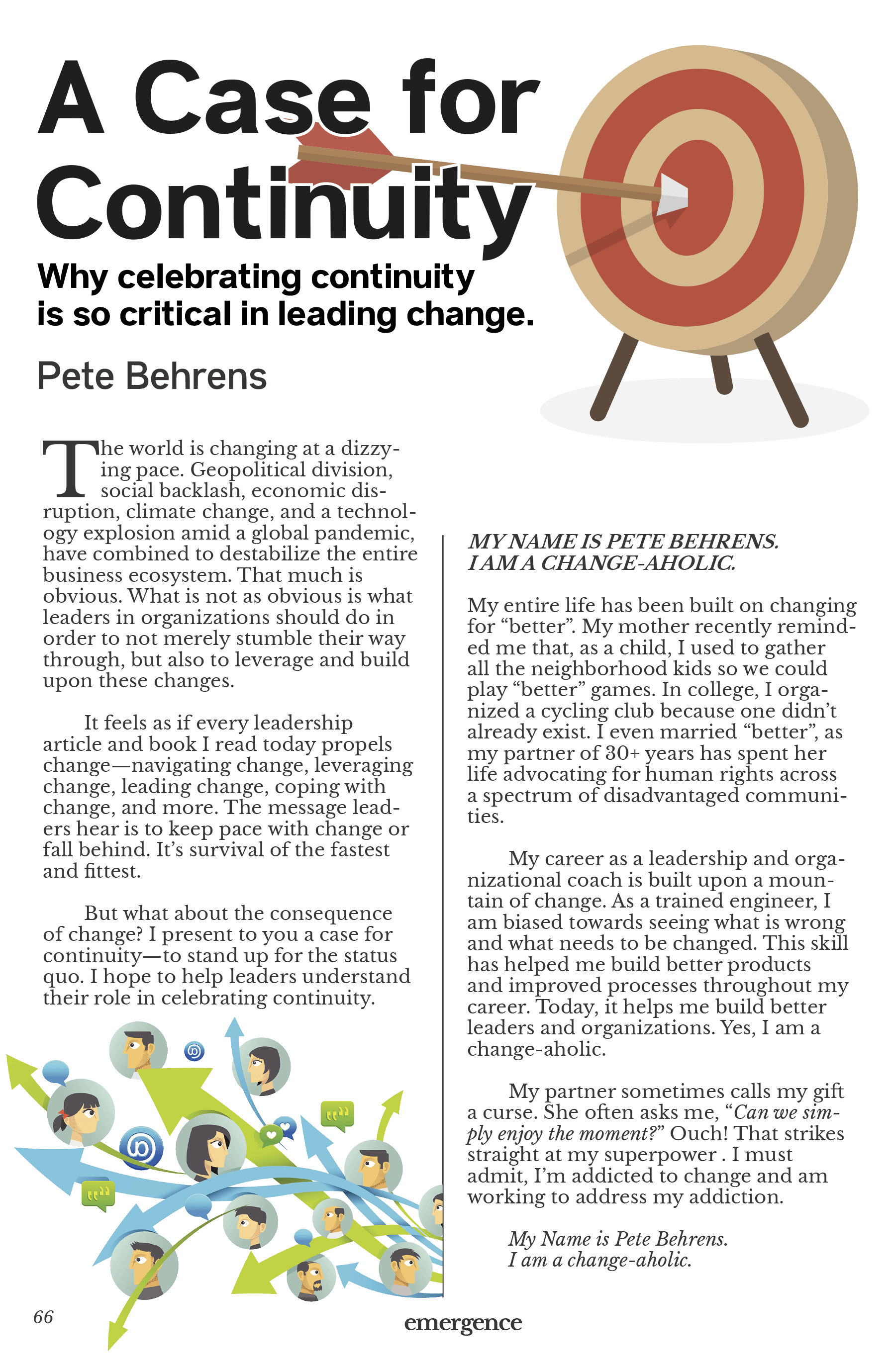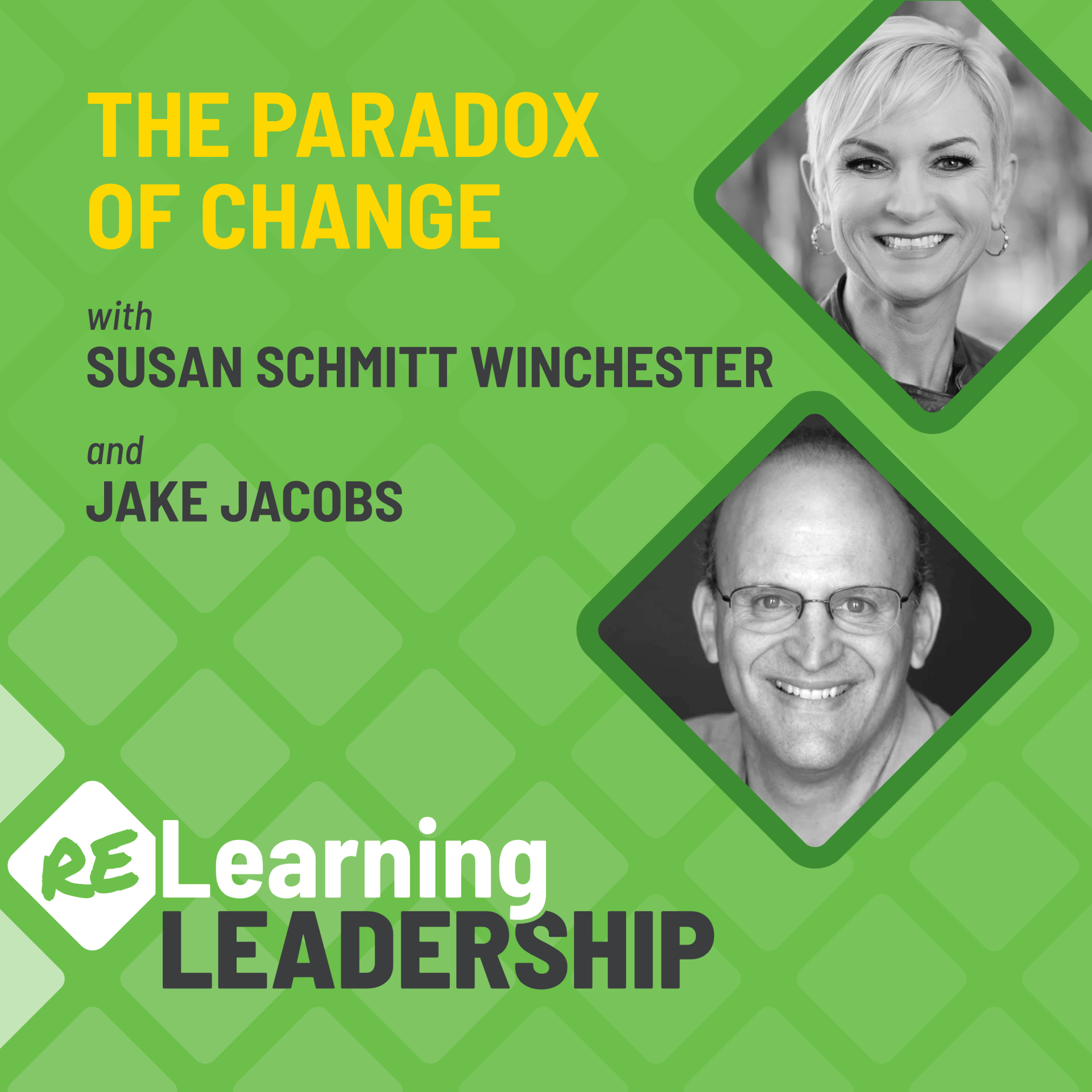A Case for Continuity
Why celebrating continuity is so critical in leading change
The world is changing at a dizzying pace. Geopolitical division, social backlash, economic disruption, climate change, and a technology explosion amid a global pandemic, have combined to destabilize the entire business ecosystem. That much is obvious. What is not as obvious is what leaders in organizations should do in order to not merely stumble their way through, but also to leverage and build upon these changes.
It feels as if every leadership article and book I read today propels change — navigating change, leveraging change, leading change, coping with change, and more. The message leaders hear is to keep pace with change or fall behind. It’s survival of the fastest and fittest.
But what about the consequence of change? I present to you a case for continuity — to stand up for the status quo. I hope to help leaders understand their role in celebrating continuity.
"My name is Pete Behrens.
I am a change-aholic."
My entire life has been built on changing for “better”. My mother recently reminded me that, as a child, I used to gather all the neighborhood kids so we could play “better” games. In college, I organized a cycling club because one didn’t already exist. I even married “better”, as my partner of 30+ years has spent her life advocating for human rights across a spectrum of disadvantaged communities.
My career as a leadership and organizational coach is built upon a mountain of change. As a trained engineer, I am biased towards seeing what is wrong and what needs to be changed. This skill has helped me build better products and improved processes throughout my career. Today, it helps me build better leaders and organizations. Yes, I am a change-aholic.
My partner sometimes calls my gift a curse. She often asks me, “Can we simply enjoy the moment?” Ouch! That strikes straight at my superpower. I must admit, I’m addicted to change and am working to address my addiction.
A change addicted world
I won’t assume you have a similar change addiction. However, I do know that the business media and consulting world is addicted to change and is pushing leaders toward the same. I also know many of my agile-focused colleagues share this affliction. We’re all selling some form of “better”.
It’s not only the business world feeling the effect of incessant change messaging. Lose weight! Get fit! Eat better! Get rich! Get more views! Sell more! Get promoted! Sound familiar? Our traditional and social media feeds are inundated with messages of “better”. Change is the wind in the sails (and sales) of an entire global ecosystem.
Whether you’re a change-aholic like me, or are simply inundated with change messages, you’ve probably already recognized that change has an outmatched budget and overwhelming fan base. This is a problem.

Change ∞ Continuity
Change does not exist in isolation. It functions in the context of stability and continuity—continuing the current state. When we talk about change, we typically isolate and focus on a single change in order to narrow and clarify our message. However, what is often overlooked in this message is everything that is not changing. So while a change focus often represents only a small percentage of an entire system, people hearing a change message tend to assume that change carries a bigger weight than it should because it receives the full focus of the discussion.
Consider a recent personal conversation I had with my partner, where I pitched moving out of our home of 20+ years. She was aghast! “How could we leave this beautiful place with a beautiful recently redesigned kitchen and patio we love, close to beautiful friends we adore? Our two children grew up here. It is not only our house, it is our home.” She was obviously surprised and threatened by my change suggestion, and expressed a myriad of concerns that were not in my change proposal. I was not suggesting leaving our town or our friends. I was not suggesting living in another house we wouldn’t come to love and enjoy. I was merely suggesting that this home, in which we raised our boys, was now too big for the two of us and no longer served our needs. I wanted to find a house within our community more aligned with our lives and to enable another young family to discover joy within this house and make it their home.
This simple personal exchange exemplifies what happens every day in every organization. Someone suggesting a change isolates a specific change message. Others hearing the change message encapsulate that change in a much broader context, increasing the perceived magnitude of the change. Recognizing that change and continuity are two intertwined sides of the same coin can help us better evaluate change and prepare our change messages. In my case, I failed to acknowledge the many positive characteristics of our home and focused only on the need for change. Had I presented a more balanced message, our exchange would have been more constructive.
As you can see, I am not suggesting we change-aholics switch teams from change to continuity. Rather, I am suggesting that change and continuity are not two different teams at all. We simply need a better balance. We need a case for continuity!
Resistors of change or celebrators of continuity?
In my personal example above, notice the perspective of my life-long partner. Even with trust and respect for me, she was still defensively triggered when I provoked a message of change. She is not unique in this respect. Each of us has a neurothreat trigger to change, especially change requests coming from others. According to David Rock, founder of the NeuroLeadership Institute and author of Your Brain at Work, proposing change on others trips multiple threat triggers of status (our identity), certainty (our clarity), autonomy (our freedom), relatedness (our connectedness), and fairness (our balance), which he simplifies as SCARF.
Egos are fragile, and vulnerable to minor slights. My partner’s brain was simply protecting against uncertainty and a loss of continuity. No human is immune to this reaction, but we can control the degree to which we’re aware of it, which helps us respond appropriately. Thus, we cannot change how others will react to change. We can only change how we present it to others (shared above) and how we perceive others’ reactions to our change requests (keep reading).
Our perceptions of others’ reactions to our change suggestions have an even more profound impact on our relationships. From one perspective, my partner saying “No!” to my proposal of moving into a new house makes her a resistor to change. This is a defensive posture toward a new future and pits her against me. However, if I shift my perspective, she is also saying “Yes!” to what she loves about our current house. This is a positive posture toward continuity. I likely share many of these same feelings and should see her as an ally.
When we shift our perspectives of others from resistors of change to celebrators of continuity, it opens us up to new relationship paradigms. We honor them (Status), share a clearer overall message (Certainty), welcome their ideas (Autonomy), connect to them (Relatedness), and are more balanced (Fairness). SCARF can be both a threat and a reward. Choosing to reward celebrators of continuity will attract friends and advocates for the change we seek.
Turning resistors into enlisters
On a recent episode of my (Re)Learning Leadership Podcast, The Paradox of Change, my two expert guests — Jake Jacobs and Susan Schmitt Winchester — explored the challenges of change and opportunities for leaders to better leverage change. In the episode, Susan shared a story of how a key union leader was pushing back on a significant plant change which included a loss of jobs. However, given an opportunity to engage in the planning and change discussion, he was able to offer a suggestion which helped drive the change forward in partnership versus fighting as adversaries. This engagement and participation influenced the leader to shift his position from that of a potential change resistor into an active change enlister, who then helped others understand the need for the change and the opportunities it would provide.
In my personal story, by listening to and empathizing with my partner’s perspectives, we were able to celebrate what we loved about our home and dream about what we could find in a new home. Through this process, not only did she join me in the change, but became the primary driver of our search and selection of the new, beautiful home we are about to move into. My superpower is visualization, her superpower is actualization. Without her, this change train would have never left the station.
Change confusion and fatigue
Change rarely—if ever—occurs in isolation. While organizations are managing the impacts of one change, another arises, then another, and so on. Some of these changes are self-inflicted (e.g. when changing a process or tool). Other changes are inflicted from the outside (e.g. a new competitor, weather incidents, economic swings, or, indeed, a pandemic!). Change comes in waves and storms, making it difficult to see the impacts of a single change. And change is never “done”.
Imagine a rock thrown into a calm pond. The rock represents change. The pond, an organization. The ripples caused by the rock represent the impact of that change. With a single rock in a calm pond, it is easy to see and manage the impact. However, as more rocks hit the pond, waves crash into each other, increasing the uncertainty and complexity of all changes. That is the reality within most organizations today: change confusion and fatigue.
Jana and I found our next dream home! However, between buying, selling, and moving, we experienced two of the biggest changes of our lifetime — my mother chose to end her six-month fight with leukemia and our neighborhood near Boulder, Colorado was devastated by a catastrophic fire (see Marshall Fire). While my mother was in hospice, the fire came literally to the doorstep of our house, destroying hundreds of homes in its path. As I write this article, I sit in a hotel room, having been evacuated from my home following my mother’s passing. Change inundated us. What is getting us through this chaos is a focus on continuity: We have our health, we have a safe place to live temporarily, we have a community with an outpouring of support for both the loss of my mother and the destruction of our neighborhood.
We cannot control change. We can only control our messaging of change, our perspectives of others’ reactions to change, and our focus on celebrating continuity that enables us to work through change.
Changing with continuity
Celebrating continuity is not a call to stop change, but a call to better balance change with it. It is a way for leaders—or, indeed, any of us—to improve our effectiveness in leading change by connecting to, engaging, and empowering others through the change process.
Steps for Changing with Continuity:
- Balancing messages of change with messages of continuity,
- Reframing resistance to change as celebrators of the status quo,
- Engaging a diversity of change perspectives and solutions through it, and
- Celebrating continuity regularly to recognize what grounds us and enables change.
Effective leadership finds paths forward (change) through the forests of the present (continuity). Leaders who craft an offensive change message, prepared for defensive resistance, should expect a fight. Leaders who engage others through a balanced discussion, where people are grounded in what is working and are able to share differing perspectives of potential change, have a chance to discover what needs changing and enlist new change agents to join them in working toward a better future.
Wherever you are reading this article, stop. Close your eyes. Take two deep breaths. What do you appreciate about this moment? As I write this article, I am looking out the window at a beautiful blue sky and a brightly shining sun. I have a warm cup of coffee at my side on a cold, brisk day. I have a comfortable couch and peaceful music playing in the background. I am celebrating my continuity which grounds and prepares me for change — both self-inflicted and external.
I often say leaders are emotional amplifiers. Leaders who are defensively SCARF’d by change amplify their negativity across the organization. Leaders who remain grounded in continuity and present clear, concise, and balanced messages will amplify their positivity across the organization. Leaders have a direct impact on the size of the rock and the resulting magnitude of the waves rolling through their organizations. Celebrating continuity is not only for others, it starts with us!
Action reflections
- Identify your bias on the “change ∞ continuity” continuum.
- Take stock in your own continuity. Identify what you personally can hold onto and celebrate today.
- Engage in a diversity of perspectives of an ongoing change in your organization or life.
- Identify someone in your organization as a celebrator of the status quo.
- Recognize what is working today in your organization. Have a party to celebrate it!
This content was originally published in the February 2022 Edition of Emergence, The Journal of Business Agility. It has been republished here with the permission of the publication.
What is Emergence?
Emergence is the Journal of Business Agility from the Business Agility Institute. Four times a year, they produce a curated selection of exclusive stories by great thinkers and practitioners from around the globe. These stories, research reports, and articles were selected to broaden your horizons and spark your creativity.









